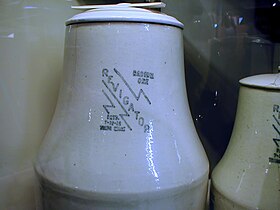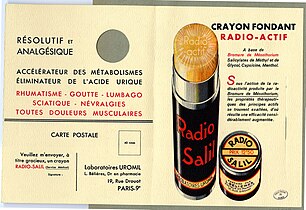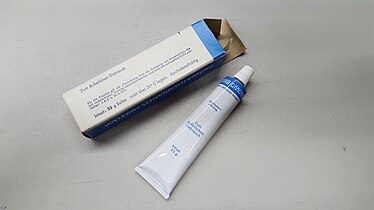|
Radium fad The radium fad or radium craze of the early 20th century was an early form of radioactive quackery that resulted in widespread marketing of radium-infused products as being beneficial to health.[1] Many radium products contained no actual radium, in part because it was prohibitively expensive, which turned out to be a grace, as high levels of radium exposure can result in radiation-induced cancer.[2] The fad began to fizzle out following the emergence of research that radium could be hazardous to health, and high-profile cases such as the Radium Girls and the death of Eben Byers, which proved this fact.[3][4] In the United States, the 1938 Federal Food, Drug and Cosmetic Act outlawed deceptive packaging, further preventing companies being able to use radium as a marketing tool.[3] Radium-infused productsRadium was added to, or used to market, a number of consumer goods. These included cosmetics, such as the brand Tho-Radia,[3] toothpaste, hair cream, and hemorrhoid cream.[4] Radium was also used to market foods and drinks, although products such as Radium Brand Creamery Butter did not actually contain any radium.[4] Radithor, an "energy drink" of distilled water with traces of radium, was marketed as a panacea.[3] One of its most famous advocates, golfer Eben Byers, died in 1932 of radium poisoning through his consumption of the product.[3][4] A number of water sources (such as bottlers or artesian hot-spring spa hotels) rebranded themselves as "radium water" or radium springs to capitalize on the craze.[5] Radium was also used to give products a glowing appearance, as in the case of watches painted with radium-containing paint.[3] Radium was also used in some ceramics, including in the production of radium water crocks, whose purpose was to irradiate drinking water.[4] Gallery
See also
References
|







